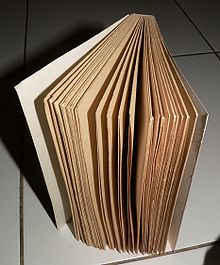Book cut
The book cut refers to the three sides of the book block on which a book can be opened. The sheets of paper are usually trimmed and stapled together in the spine of the book .
technology
The paper on which a book is printed comes in rolls or sheets . The size of hand-scooped paper depends on the size of the ladle. In accordance with the sheet size, a plurality of set levels arranged that by appropriate folding of the pressure after the base sheet to be brought into the correct page order. In order to be able to open the pages after binding , they must first be "cut open". This is how the term book cut comes about.
Types of book cut
The book block , consisting of several layers , is trimmed on three sides.
Front cut
Front cut is the side of the book cut that is opposite the spine of the book . Books from the 15th and 16th centuries often have the book title on the front cut , as it was common at that time to store the books lying down with the front cut facing forward.
Top cut or head cut
Upper section or head section is called the cut at the top edge of the book block.
Undercut or foot cut
Undercut or foot cut (obsolete Queue ) is called the cut of a book on the bottom, so the page on which the book is upright.
Hollow cut
For books with a round spine, the front cut is rounded inwards and thus becomes a hollow cut . The cut is being made straight, the curvature is only created by moving the entire book block to the round book spine .
Exceptional cases are:
Non-cropped books
Non-trimmed - also uncut - books (non coupé) consist of intact, only folded sheets. The book block is still uncut. Such volumes can be valuable to bibliophiles because these books were never completed - sometimes by mistake - and can be unique . From the 19th century onwards, the binding of an uncut book block with subsequent manual page-by-page cutting can also have purely aesthetic reasons. In contrast, book blocks in interim bindings are not infrequently still uncut.
The rough book cut
If the sheets have only been cut open at the folds, one speaks of a rough book cut or uncut . The margins are not narrowed. A book with a rough cut is also called “non rogné” (French: not trimmed), “Rough Cut” or “Deckle Edge” (with an edge like hand-made sheets of paper). The book then still has the original width of the printed sheets , because these are only cut open by the bookbinder without changing the size of the paper sheet. In some cases the head cut can be done as a gold cut.
Cut decorations
The book cut can be decorated with colors or other materials for protection, but also for aesthetic reasons: This is called cut decoration . There are several types of cut decoration, such as: B. the color cut, the blast cut, the gold cut, the peel cut, the marble cut. Gold cuts were also hallmarked on representative bindings . In the 19th century, books were occasionally provided with a fore-edge painting, images hidden in the book cut.
Defects in the cut
The term from the book trade book cut (slightly) shortened means that the front cut was made shorter than the layout specified. The technical term in bookbinding is undercut .
See also
literature
- Steven K. Galbraith: Edges of books: specimens of edge decoration from RIT Cary Graphic Arts Collection . Rochester (NY), RIT Cary Graphic Arts Press, 2012, ISBN 978-1-933360-69-0 .
- Dieter Liebau, Inés Heinze: Industrial bookbinding. 3. Edition. Verlag Beruf + Schule, Itzehoe 2010, ISBN 978-3-88013-679-3 .
- Ursula Rautenberg (Hrsg.): Reclams Sachlexikon des Buches. 2nd improved edition. Reclam, Stuttgart 2003, ISBN 3-15-010542-0 .
- Helmut Hiller, Stephan Füssel: Dictionary of the book. 6th fundamentally revised edition. Vittorio Klostermann, Frankfurt am Main 2002, ISBN 3-465-03220-9 .
Web links
Individual evidence
- ↑ Dieter Liebau, Inés Heinze: Industrial bookbinding. 3. Edition. Verlag Beruf + Schule, Itzehoe 2010, ISBN 978-3-88013-679-3 , p. 57


